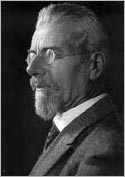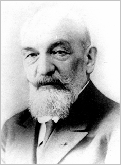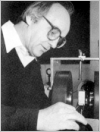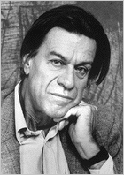[Discovery of liquid
crystals (LC)]

Between 1850 and 1888, people from
different fields like chemistry, biology observed strange behavior
in some materials when the temperature is approaching the melting
point. W. Heintz, a German biochemist, reported in 1850 that stearin
melted from a solid to a cloudy liquid at 52<C, changed at 58<C to
an opaque and at 62.5<C to a clear liquid. Others reported observing
blue colors when compounds synthesized from cholesterol were cooled.
Biologists observed anisotropic optical behavior in "liquid"
biological materials, a behavior usually expected only in the
crystal phase.
In 1888, Friedrich Reinitzer, an
Austrian botanist observed that there was two melting points for a
certain material while he was making esters of cholesterol for
studying cholesterol in plant. This material is now known as
cholesteryl benzoate. He also observed birefringence and iridescent
colors between these two melting points.

However, Reinitzer did not know what
shall be done about this
discovery; therefore he consulted with van
Zepharovich, a
crystallographer in Prague. van Zepharovich suggested that Reinitzer
contact Otto Lehmann, a physicist in Karlsruhe, Germany, for further
discussion, because Lehmann is the first to use hot stage on a
polarized optical microscope, which later became the standard
equipment for liquid crystal research. Following Zepharovich’s
advice, Reinitzer then contacted Lehmann concerning the
two-melting-points phenomenon. Their discussion by mails finally
lead to the first real investigation of liquid crystals, eventually
to fundamental understandings of the nature of this new phase of
matter. Lehmann and Reinitzer may thus with some justification be
called the grandfathers of liquid crystal science.
|
After the discovery, the liquid crystal research flourished.
In 1922, Georges Friedel suggested a classification scheme
to name different phases of liquid crystals called nematic,
smectic and cholesteric, which are still used today. |
 |
|
Carl Oseen in Sweden worked on elastic properties of liquid
crystals and his results were used on the continuum theory
by England's F.C. Frank. This theory became one of the
fundamental theories in liquid crystals today. |
 |
|
V. Freedericksz
in the 1930¨s. The transition from a homogeneous to a
deformed structure at some critical value of applied field
strength is named Freedericksz transition due to his pioneering work in this
area. |
 |
|
Alfred Saupe, a German physicist, later working at Kent
State University, worked together with his advisor Wilhelm
Maier in Karlsruhe 1958 on his thesis ("Diplomarbeit"), a
molecular theory of liquid crystals not involving permanent
dipoles as Max Born's theory did. This work gave rise to the
Maier-Saupe Theory, another well-known basic theory of
liquid crystals. |
 |
From 1945 to 1958, everything seemed
slow down in the liquid crystal field. People thought they knew
everything about liquid crystals and that nothing new could be
expected in this area. Even worse, they were not even included in
textbooks. An entire decade of growing scientists did not have
contact with liquid crystals. No one could yet imagine how large a
role liquid crystals would play in technical applications today.
|
In
1958 Glenn Brown, an American chemist, published an
article in Chemical Reviews on the liquid crystal
phase and subsequently sparked an international resurgence
in liquid crystal research. |
 |
 Pierre-Gilles
de Gennes, the laureate of Nobel Prize in Physics 1991,
becomes the first and so far the only person receiving
this prize in the
field of liquid crystals. He was awarded
"for
discovering that methods
developed for studying order phenomena in simple systems
can be generalized to more complex forms of matter, in
particular to liquid crystals and polymers".
Pierre-Gilles
de Gennes, the laureate of Nobel Prize in Physics 1991,
becomes the first and so far the only person receiving
this prize in the
field of liquid crystals. He was awarded
"for
discovering that methods
developed for studying order phenomena in simple systems
can be generalized to more complex forms of matter, in
particular to liquid crystals and polymers".
Further Readings
and References:
Y. S.
Chandrasekhar, "Liquid Crystals", Cambridge University Press
(1992).
P. G. de Gennes and
J. Prost, "The
Physics of Liquid Crystals", Oxford University Press (1995).
J. A. Castellano,
"Liquid Gold: The Story Of Liquid Crystal Displays and the Creation
of an Industry",
World Scientific Publishing (2005)